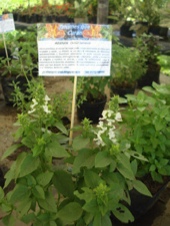
Basil (Albahaca) - Ocimum basilicum
We ask Basil to harmonize
This spice rack hero packs a serious medicinal punch. Just one-half cup of this highly aromatic, perennial herb contains 97.7% of the recommended daily allowance of vitamin K. Plus it tastes and smells great. Basil grows to 19 inches tall. Its stem, usually square, bears many branches. Leaves are highly aromatic, usually ranging in size from 1/2 to 1 inch in length. Its flowers are green, turning brown when the seed is mature. Basil has been used as a medicinal for thousands of years
WHERE IT CAN BE FOUND:
Mexico, North America, Central America,
South America, tropical Asia, Europe
PROPERTIES AND USE:
There are more than 60 varieties of basil, with health benefits varying slightly by variety. But in general, it is antibacterial, anti-inflammatory, diaphoretic, carminative, antispasmodic, stomachic, tonic, antimalarial, good for cardiovascular health, the eyes, to treat nausea, vomiting, urinary tract ailments, high cholesterol, diseases of the liver, intestinal parasites, earache, headache, depression, anorexia, sore muscles. It is especially helpful for women's health: delaying menstruation, easing the pain of menstruation, and healing after childbirth.
TRADITIONAL PREPARATION:
For fever reduction, nausea, intestinal parasites, and diseases of the liver, boil 2 tablespoons dried basil in 8 ounces water for 2 minutes. Prepare twice per day, and drink while hot. For sore muscles, combine 2 tablespoons dried, chopped basil with 1/4 cup organic olive oil. Smooth on the affected area.
BASIL TEA Makes 1 cup
Suffering from indigestion, menstrual pain, vomiting, diarrhea, or high cholesterol? This simple tea is for you!
INGREDIENTS:
1 tablespoon chopped dry
or 3 tablespoons chopped fresh basil
INSTRUCTIONS:
¥ Pour 1 cup boiling water over the basil.
¥ Strain, and drink in one serving
USE:
You may drink up to 3 cups per day.
Albahaca blanca, Ocimun basislicum
Hierva aromática, se utilizan las hojas y tallo. Como condimento se utiliza para ensaladas y pastas. La infusión se usa para el tratamiento de afecciones gastrointestinales y desordenes estomacales. El aceite esencial presenta actividad antimicrobiana, antifúngica (hongos y bacterias), inhibe la formación de coagulos y trombos en arterias y venas. Es antiflatulento, para el tratamiento de la distensión abdominal y dolores abdominales, se recomienda beber una taza después de las comidas. Su aceite esencial es contraindicado en el embarazo, lactancia y niños.
Hierva aromática, se utilizan las hojas y tallo. Como condimento se utiliza para ensaladas y pastas. La infusión se usa para el tratamiento de afecciones gastrointestinales y desordenes estomacales. El aceite esencial presenta actividad antimicrobiana, antifúngica (hongos y bacterias), inhibe la formación de coagulos y trombos en arterias y venas. Es antiflatulento, para el tratamiento de la distensión abdominal y dolores abdominales, se recomienda beber una taza después de las comidas. Su aceite esencial es contraindicado en el embarazo, lactancia y niños.

